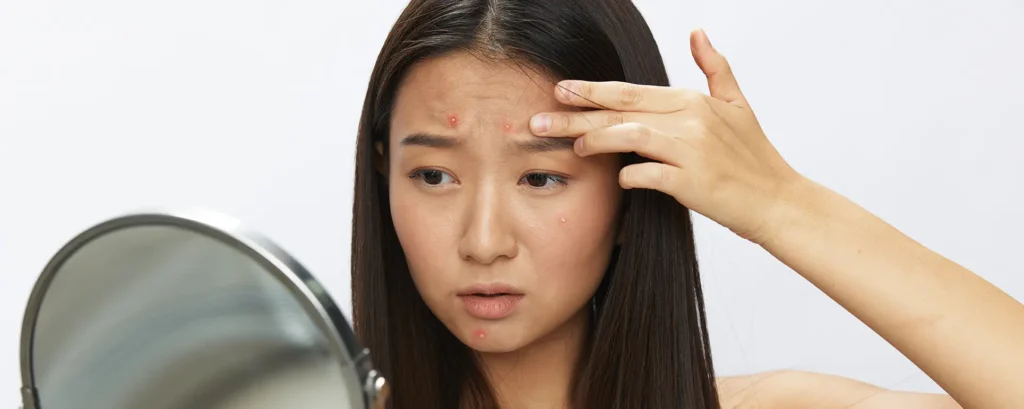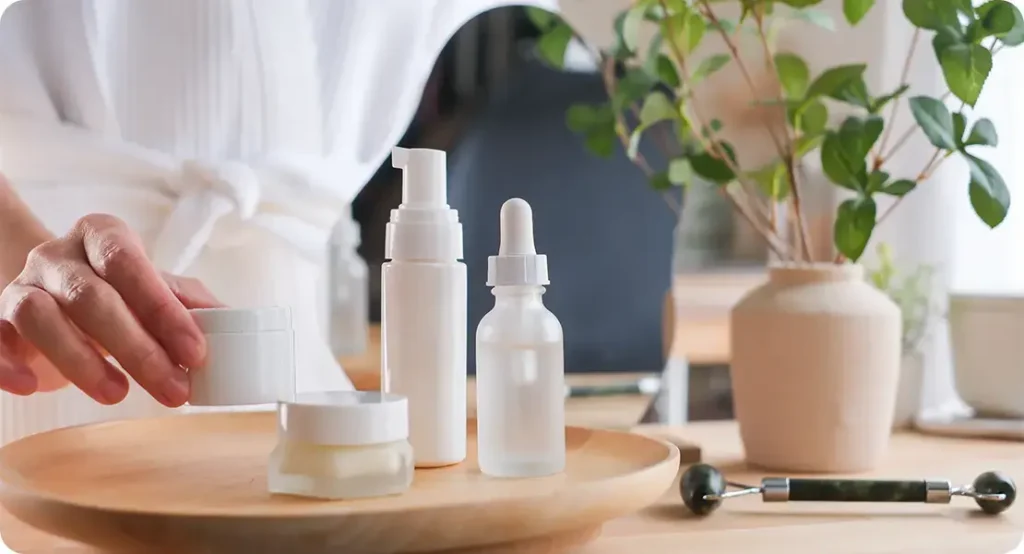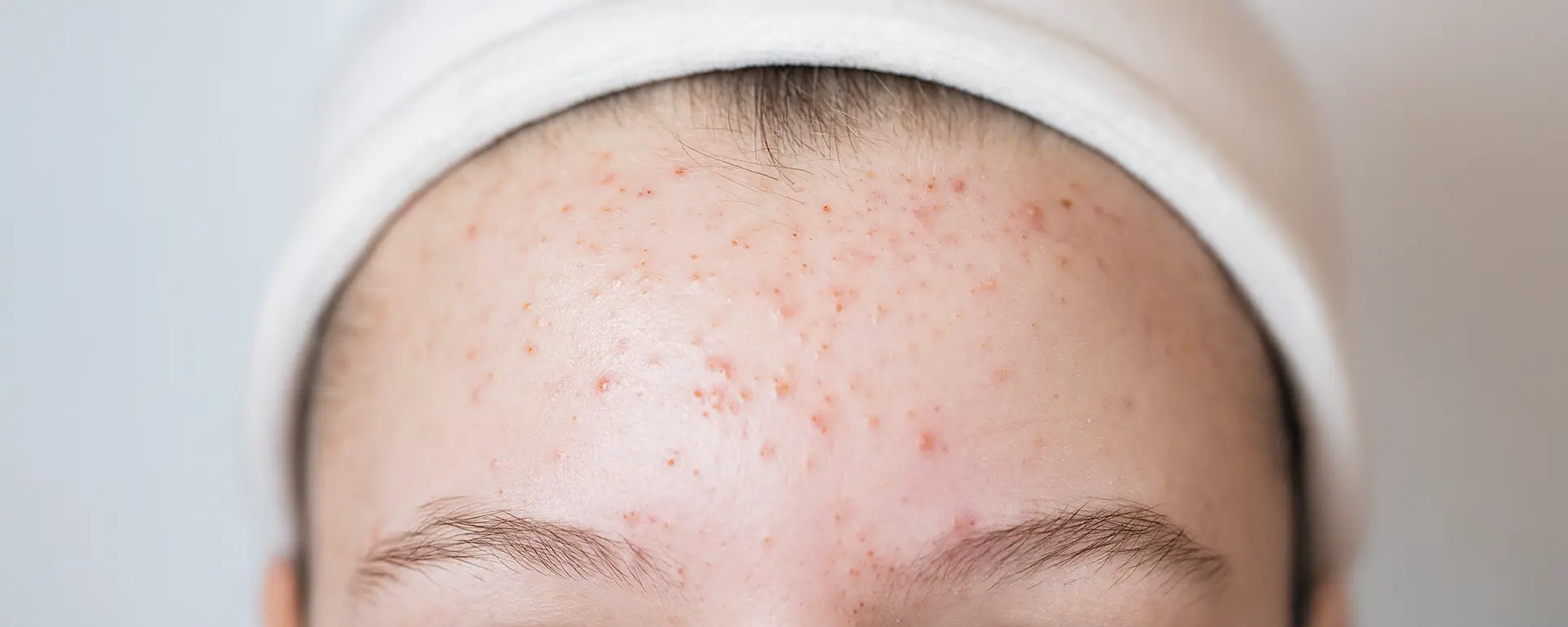If you’re someone who often wakes up only to find yet another pimple sitting right in the middle of your forehead, you’re far from alone. Forehead breakouts are one of the most common skin issues people deal with, regardless of age, gender, or skin type. For many, it feels like the forehead is a magnet for spots they appear just before an important event, during periods of stress, or even after you’ve taken extra care to clean your skin. And because your forehead is right at the centre of your face, these blemishes can feel much more noticeable and harder to hide compared to spots on other parts of the body.
The frustration with forehead acne is that it often seems unpredictable. You might be following a careful skincare routine, washing your face regularly, and still find breakouts popping up. That can leave you wondering whether your spots are caused by hormones, diet, stress, or even hair products. The truth is, there isn’t always one single cause forehead spots often result from a mix of factors, which makes them tricky to manage without expert guidance.
So, what exactly is happening beneath the surface of your skin? On a basic level, spots form when your pores become clogged with oil, dead skin cells, and bacteria. But the forehead has unique features that make it more prone to this. It sits within the “T-zone” of your face, an area that naturally produces more oil. Add in the fact that your forehead is frequently exposed to hair, sweat, makeup, or even hats and helmets, and you can start to see why it’s such a common site for pimples.
For some people, breakouts may be linked to lifestyle choices such as diet, irregular sleep patterns, or stress, all of which can affect your hormones and oil production. For others, skincare and haircare products that are too heavy, greasy, or irritating can cause a type of acne known as “pomade acne” along the hairline and forehead. And then there are those who may simply be more genetically prone to acne overall, meaning the forehead is one of the first places they notice flare-ups.
The good news is that forehead spots can be treated but the best approach often depends on identifying the root cause. That’s why dermatologists take a closer look rather than recommending a one-size-fits-all solution. They’ll assess not only the type of spots you’re dealing with whether they’re blackheads, whiteheads, pustules, or deeper cysts but also your daily routine, health background, and even environmental factors that could be contributing to your skin concerns.
In this guide, we’ll take you through the most common reasons behind forehead breakouts, explain what dermatologists look for when assessing your skin, and explore the treatments that actually work. Whether you’re struggling with occasional pimples or ongoing flare-ups, understanding the science and triggers behind forehead acne is the first step towards finally keeping it under control.
1. Clogged Pores: The Most Common Culprit

One of the main reasons spots appear on your forehead is because of clogged pores. Your skin is covered in tiny openings called pores, and each one is connected to an oil gland. These glands produce sebum, a natural oil that helps keep your skin hydrated and protected. When everything is balanced, sebum is beneficial. But when too much oil is produced, it can mix with dead skin cells, dirt, sweat, or even remnants of makeup and sunscreen. This mixture can block the pore, creating the perfect environment for bacteria to thrive. The result? Red, inflamed spots that tend to cluster on your forehead.
The forehead in particular is vulnerable to clogged pores because it sits within the T-zone the area of your face (forehead, nose, and chin) that tends to be oilier than the rest. People with naturally oily skin are even more prone to pore blockages here. And it’s not only your skin type that plays a role. Daily habits such as skipping cleansing, touching your face with unwashed hands, or letting sweat sit on your skin after exercise can all make clogged pores worse.
Another factor to consider is the environment. Pollution, dust, and even the residue from hair products can easily settle on the forehead throughout the day. If not cleansed away properly, these can build up inside the pores, making breakouts far more likely. This is why many people find their forehead acne flares up more during hot, humid weather or after long days spent outdoors.
Dermatologist’s Note: It’s important to understand that over-cleansing isn’t the answer. Many people try to scrub their skin aggressively to “unclog” pores, but this can backfire. Harsh scrubbing strips the skin of its natural oils, which signals your oil glands to produce even more sebum, leading to a cycle of breakouts. Instead, dermatologists recommend gentle, consistent care.
Tip for Clearer Skin:
- Wash your face twice daily with a mild cleanser designed for your skin type.
- Avoid harsh soaps or cleansers with too many drying ingredients, as these can cause irritation.
- Exfoliate 1–2 times a week with a gentle chemical exfoliant (like salicylic acid) rather than a rough physical scrub. This helps dissolve the oil and dead skin inside pores without damaging the skin barrier.
- If you wear makeup or sunscreen, make sure you remove it thoroughly every evening to prevent build-up.
By keeping your pores clear and treating your skin gently, you can significantly reduce the number of forehead spots that appear. It’s a simple step, but one that forms the foundation of any effective acne-prevention routine.
2. Hair and Skincare Products

Believe it or not, the products you use on your hair and skin could be playing a major role in your forehead breakouts. This type of acne is sometimes called “pomade acne”, a term dermatologists use to describe spots caused by heavy hair products that seep onto the skin. Shampoos, conditioners, leave-in treatments, gels, serums, and oils can all leave behind a residue that trickles down onto your forehead, especially around the hairline. These residues often contain ingredients such as silicones, waxes, or oils that can clog pores and trigger spots.
Skincare products can have the same effect. While moisturisers and sunscreens are essential for healthy skin, using formulas that are too heavy, greasy, or not suited for your skin type can backfire. Thick creams may block pores, while fragranced products can irritate sensitive skin, leading to small bumps or breakouts on the forehead. Sunscreens, although vital for protecting against UV damage, are a frequent culprit too some formulas feel greasy or leave a film that encourages clogged pores.
The placement of these breakouts can sometimes be a giveaway. If your spots appear mainly along your hairline or just beneath your fringe, there’s a strong chance that haircare products are contributing. Similarly, if pimples seem to show up after you’ve switched moisturisers, face oils, or sunscreen brands, your skincare might be the cause.
Dermatologist’s Note: Many patients don’t realise that “natural” or “organic” products can be just as pore-clogging as synthetic ones. Ingredients like coconut oil, cocoa butter, or certain plant-based waxes, although marketed as healthy, are highly comedogenic (meaning they block pores easily). That’s why dermatologists recommend focusing on the label term “non-comedogenic” which simply means the product is less likely to clog pores rather than whether the product is natural or chemical-based.
Tips to Prevent Product-Related Breakouts:
- Look for non-comedogenic, oil-free, and fragrance-free labels on both skincare and haircare products.
- Apply conditioner from the mid-lengths to the ends of your hair, rather than directly onto your scalp, to reduce the chance of residue dripping onto your forehead.
- Rinse thoroughly after shampooing and conditioning to remove excess product.
- If you have a fringe or regularly wear your hair across your forehead, wash your hair more frequently to prevent oil build-up transferring onto the skin.
- For skincare, choose lightweight moisturisers (gel or lotion textures) and broad-spectrum sunscreens made for acne-prone or sensitive skin.
Making small changes in your hair and skincare routine can make a noticeable difference in forehead acne. For many people, simply swapping out a heavy moisturiser or switching to a lighter conditioner is enough to clear breakouts in this area within a few weeks.
3. Hormonal Fluctuations
Hormones are one of the biggest internal triggers for forehead acne. Your skin’s oil glands are highly sensitive to hormonal changes, particularly androgens a group of hormones that includes testosterone. When androgen levels rise, they signal your sebaceous glands to produce more sebum (oil). While a certain amount of sebum is healthy, too much of it increases the risk of clogged pores, blackheads, and inflamed breakouts, especially in oil-prone areas like the forehead.
This is why many people notice that their forehead acne tends to flare up during specific phases of life or situations:
- Puberty: Rising hormone levels are a major reason teenagers commonly develop forehead spots first, often before acne appears on other areas of the face.
- Menstrual cycles: Many women experience a surge of breakouts around their period due to fluctuating oestrogen and progesterone levels.
- Stress: High stress triggers the release of cortisol, which can indirectly stimulate more oil production and worsen inflammation, leading to stress-related pimples.
- Other hormonal conditions: Issues such as polycystic ovary syndrome (PCOS) or endocrine imbalances may also show up as persistent forehead acne.
Unlike product-related or environmental acne, hormone-driven breakouts can feel more stubborn. They may appear in cycles (for example, monthly before menstruation), or they may be persistent if there’s an ongoing hormonal imbalance. Often, these spots are not just blackheads or whiteheads but deeper, inflamed pimples that take longer to heal.
Dermatologist’s Note: It’s important to understand that while you can’t completely stop your hormones from fluctuating, you can manage their impact on your skin. Dermatologists often recommend treatments tailored to hormonal acne, such as topical retinoids, benzoyl peroxide, or prescription-strength options like hormonal therapies. In some cases, oral contraceptives or anti-androgen medications are suggested for women if breakouts are clearly linked to hormone fluctuations.
Tips to Manage Hormonal Acne:
- Keep a diary of when your forehead breakouts tend to appear this can help you and your dermatologist identify a hormonal pattern.
- Maintain a consistent skincare routine even when your skin feels relatively clear; this can help prevent flare-ups before they start.
- Manage stress with lifestyle approaches such as exercise, better sleep, or mindfulness, as stress hormones can worsen breakouts.
- Seek professional advice if your acne feels severe, painful, or persistent especially if it coincides with other hormonal symptoms like irregular periods, excess hair growth, or sudden changes in weight.
Hormonal acne is a very common reason for forehead spots, and while it can be challenging to control on your own, dermatology-led treatments often provide significant improvement. With the right approach, even hormone-driven breakouts can become manageable.
4. Stress and Lifestyle Factors
While stress itself doesn’t directly create pimples out of thin air, it plays a powerful role in making forehead breakouts worse. When you’re under stress, your body releases a hormone called cortisol, often referred to as the “stress hormone.” Cortisol affects many systems in your body, including your skin. Higher cortisol levels stimulate your sebaceous glands, causing them to produce more oil than usual. This excess oil can clog pores, particularly in oily-prone areas like the forehead, and make existing breakouts more inflamed.
It’s not just cortisol that links stress to skin problems. Stress also triggers inflammation throughout the body, slows down the healing process, and can weaken your skin barrier. This means that when you’re stressed, not only are you more likely to develop pimples, but those pimples may take longer to heal and leave marks behind more easily.
Lifestyle habits often add fuel to the fire. Consider how your daily routine might impact your forehead breakouts:
- Poor sleep: Lack of sleep increases cortisol levels and reduces your body’s ability to repair skin overnight. This can make acne flare-ups worse and leave skin looking dull.
- Unhealthy diet: Diets high in sugar, refined carbs, and processed foods can spike insulin levels, which in turn affect hormones linked to oil production. Greasy or fast foods may not directly “cause” acne, but they can worsen inflammation and make flare-ups more frequent.
- Dehydration: When your body is dehydrated, your skin often overcompensates by producing more oil. This oil imbalance, combined with a lack of water, makes the forehead more prone to clogged pores.
- Busy lifestyle choices: Skipping your skincare routine when tired or rushing can mean that sweat, makeup, and pollution sit on your forehead for longer, leading to congestion.
Dermatologist’s Note: Dermatologists often see patients whose breakouts get worse during exam periods, work deadlines, or times of personal stress. Addressing stress doesn’t just improve your mental health it can have a visible, positive impact on your skin as well.
Tips to Reduce Stress-Related Breakouts:
- Aim for 7–8 hours of quality sleep each night, as this helps regulate cortisol levels and allows your skin to repair.
- Incorporate stress management techniques such as yoga, meditation, journaling, or even regular walks outdoors.
- Focus on a balanced diet rich in whole foods, fruits, vegetables, lean proteins, and omega-3 fatty acids, which have anti-inflammatory benefits for the skin.
- Stay well-hydrated by drinking enough water throughout the day hydration supports a healthier skin barrier and prevents excessive oiliness.
- Don’t skip your basic skincare routine, even during stressful times. Gentle cleansing, moisturising, and sunscreen can go a long way in keeping breakouts under control.
By addressing both stress and everyday lifestyle choices, you can significantly reduce the frequency and severity of forehead acne. While it may not completely eliminate spots, creating healthier habits often makes treatments prescribed by dermatologists work even more effectively.
5. Friction and Sweat
If you regularly wear hats, helmets, headbands, or even keep your fringe covering your forehead, you may notice more spots in this area. That’s because friction and trapped moisture can irritate the skin and block pores. Sweat itself isn’t harmful, but when it mixes with oil, dirt, and bacteria on the skin’s surface, it creates the perfect conditions for pimples to form. Dermatologists often refer to this type of breakout as “mechanical acne”, since it’s triggered by physical rubbing and heat rather than internal factors.
Tip: Cleanse your forehead gently after workouts or heavy sweating, and whenever possible, choose lightweight, breathable fabrics. If you wear helmets or headgear regularly, clean the straps and padding often to reduce bacteria build-up.
6. When to Seek Professional Help
Occasional forehead pimples are common, but if your breakouts are persistent, painful, or leaving marks and scars, it may be time to see a dermatologist. Professional assessment is important because not all forehead acne is the same. A dermatologist can determine whether you’re dealing with clogged pores, hormonal acne, or even another skin condition that looks similar but requires different treatment.
Some of the treatment options a dermatologist may recommend include:
- Prescription topical creams – such as retinoids to unclog pores, topical antibiotics to reduce bacteria, or stronger formulations of benzoyl peroxide to target inflammation.
- Oral medications – like antibiotics, hormonal therapy (such as the contraceptive pill), or isotretinoin in more severe cases. These are often used when topical treatments alone aren’t enough.
- Targeted procedures – including chemical peels, laser therapy, or light-based treatments that reduce oil production and kill acne-causing bacteria.
Dermatologist’s Advice: Don’t wait until acne becomes severe or starts scarring to get help. Early treatment can prevent long-term damage and restore skin confidence much faster.
Final Thought: Clearer Skin Starts with the Right Approach
Forehead breakouts are common, but understanding the triggers makes them easier to manage. From clogged pores and hair products to hormones and stress, multiple factors can contribute. With proper skincare, lifestyle adjustments, and dermatologist guidance, you can reduce spots and keep your forehead clear. Remember, consistent care and professional advice go a long way in managing acne effectively. If you’re struggling with persistent forehead pimples, consider consulting an Acne Clinic in London for personalised treatment options.
References:
Leung AKC et al. (2021) Dermatology: how to manage acne vulgaris. Journal of Dermatological Treatment. Available at: https://www.ncbi.nlm.nih.gov/pmc/articles/PMC8510514/
Verywell Health (2023) Causes of Forehead Acne and What to Do About It. Available at: https://www.verywellhealth.com/forehead-acne-7505280
Healthline (2025) Forehead Acne: Causes, Treatments, and Prevention. Available at: https://www.healthline.com/health/forehead-acne
Medical News Today (2024) Acne mechanica: Symptoms, causes, treatments, and more. Available at: https://www.medicalnewstoday.com/articles/acne-mechanica
Dreno B. (2018) The influence of exposome on acne. Journal of the European Academy of Dermatology and Venereology, 32(Suppl 2), pp. 5–11. Available at: https://www.ncbi.nlm.nih.gov/pmc/articles/PMC5947266/
